The need for nutrition is not the primary need that is met in skin-to-skin contact between mother and baby. We can rather say that what is satisfied is the need for protection and care, no less important than the nutritional one. This is because the breastfeeding experience is one of the very first and instinctive forms of contact that the newborn experiences with the world, the prototype of the relationships it will have in the future.
Breastfeeding and research
Many studies of “Infant Observation” have shown that the newborn, from birth, if placed on the mother’s body, reaches the breast in total autonomy. In some tribes still present in remote parts of South America, the child, once born, is not immediately taken, washed, detached from the umbilical cord, as in Western customs. Instead, it is left soft and empty on the maternal womb, with the umbilical cord, living for a few minutes thanks to double breathing, and free to climb towards the breast, as if it already knew where it is.
Recent discoveries however, underline how the chemical content of mother’s milk can positively affect the neuronal development of the child. The LCPUFAs (polyunsaturated fatty acids) contained in human breast milk are critical contributors to white matter development (myelination) during infancy, which explains the improvement in cognitive and intellectual functioning. The mother is able to trigger high levels of endogenous opioids, responsible for the pleasantness of the interactions. In turn, endogenous opioids trigger the production of corticotropin-releasing factor in the child’s hypothalamus which, by controlling the production of endorphins and ACTH in the anterior pituitary, stimulates the production of dopamine. The biochemical cascade that is activated in the interactions between mother and child, in a relationship of intimate and lasting contact, favors the birth of new neurons and protein synthesis.
Monitor your body: recognize the early signs of mastitis.
We dedicate this article to mastitis, a diagnosis much feared by breastfeeding women (and not only), because we believe that offering women tools suitable for monitoring their physical condition can contribute positively to the optimal resolution of the breastfeeding relationship, benefiting above all to the psychic-humoral aspect of the dyad. The psychic condition of the mother who, in the whirlwind of all the new events that result in the birth of a new life, has to face considerable physical and mental resistance, and any unforeseen event can lead to despair.
Location.
Mastitis in breastfeeding is often the extreme consequence of untreated breast engorgement or obstruction of a duct, which can be superimposed on by a bacterial infection caused by Staphylococcus aureus, in turn favored by nipple lesions (fissures, caused by incorrect suction), which represent an entrance door for germs. It is a sensitive, very hot, wedge-shaped area of the breast, usually accompanied by fever exceeding 38.5 °C, so that its symptoms can be confused with those of the flu: pain, fever, inflammation. It can often compromise the desire to breastfeed in some women, but if treated promptly, it is not a valid reason for stopping breastfeeding. In fact, continuing to breastfeed your baby can be of great help in healing.
Not just breastfeeding. In fact, non-puerperal mastitis, i.e. inflammation of the breast that can occur at any stage of a woman’s life due to factors independent of breastfeeding, is caused not only by poor local hygiene, but also by a hormonal imbalance.
How can a breastfeeding mother recognize mastitis?
The symptoms are very annoying, generate discomfort and compromise the quality of life during the puerperium. Between these:
• Breast pain, mostly unilateral;
• Presence of a warm and hardened area of the breast with a red streak;
• Fever greater than or equal to 38.5°C associated with flu-like symptoms, such as chills, joint pain, tiredness, loss of appetite, general malaise, hot flashes, sweating, exhaustion and a sense of fatigue.
Mastitis is distinguished from a simple mammary engorgement, due to the specific symptoms described above. As mentioned, in fact, in the case of mastitis it is frequent, in addition to the discomfort and hardening of the breast, the appearance of fever, chills and a characteristic red streak. Typical symptoms of obstruction are the perception of a lump and reddening of the skin over the lump.
Danger to the baby?
Breastfeeding should be encouraged in the presence of mastitis. In fact, mothers are often afraid that mastitis could interfere with breastfeeding and hurt their baby. It is important to underline that this disorder can be treated with specific compatible drugs and without the need to stop breastfeeding, unless there is an explicit request, for personal reasons, on the part of the woman. Sucking the newborn can be an excellent ally for the healing process: a sudden interruption of breastfeeding could, on the contrary, exacerbate mastitis and increase the risk of abscess formation.
Causes.
Most gynecologists agree that many cases of mastitis in breastfeeding women are caused by milk stasis or infections, i.e. when:
– A child who is not properly attached, a situation that can be resolved with the help of a midwife, by improving the position;
– Ankyloglossia, a malformation of the oral cavity that limits the movements of the tongue;
– Infrequent breastfeeding, for example when the newborn starts sleeping through the night, or a tendency to bottle-feed in cases of mixed breastfeeding;
– Breastfeeding not divided between the two breasts, for example because a nipple is sore.
– There is physiological bacterial presence on the breast, which could penetrate through a small wound or from the mouth/throat of the infant during breastfeeding;
– Fissures, small cuts or abrasions on the nipple, indicative of a bad fit in the baby.
Self-monitoring followed by medical consultation: Why is prevention better than cure?
In most cases, the mother experiences flu-like symptoms a few hours before noticing that part of one of the breasts is red and sore. As soon as this combination of signs and symptoms appears, it is already time to call the doctor because it is a clinical condition that should not be underestimated and in which the link between the psychic and the physical is very strong and conditioning.
The mother serves as an emotional and bodily container. It is also true that severe stress can negatively affect the breastfeeding relationship. In fact, it is not important to force oneself into exclusive breastfeeding: it is important that breastfeeding, whether natural or artificial, is stress-free. Therefore, it remains a relationship subject to numerous intervening variables that should be considered. The different and natural aptitudes of the newborn could intimidate the mother, risking dragging the mother-child pair into a compromised dialogue, as it is disturbed by background noise. Thus breastfeeding, which has every possibility of being a source of wealth and stimulus for both partners when it satisfies desires and calms fears, on the contrary, where it confirms fears or causes disappointments, runs the risk of becoming an increasingly repetitive behavior pathological and full of anxiety.
Edited by Dr. Giovanna Giarrusso

